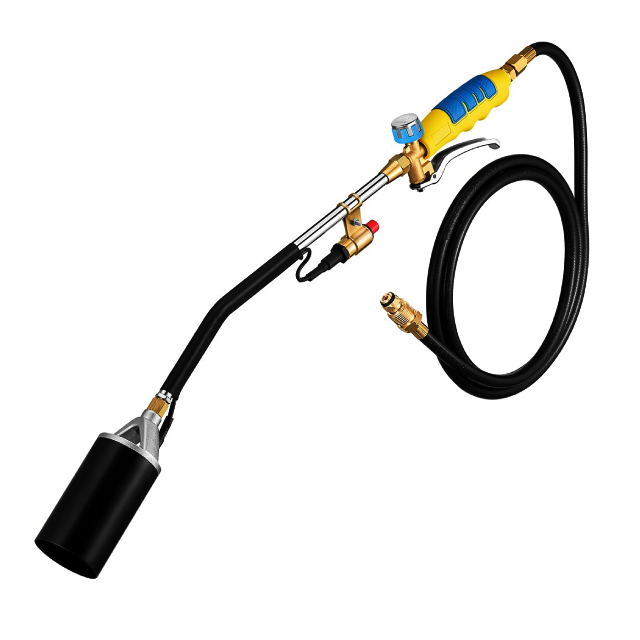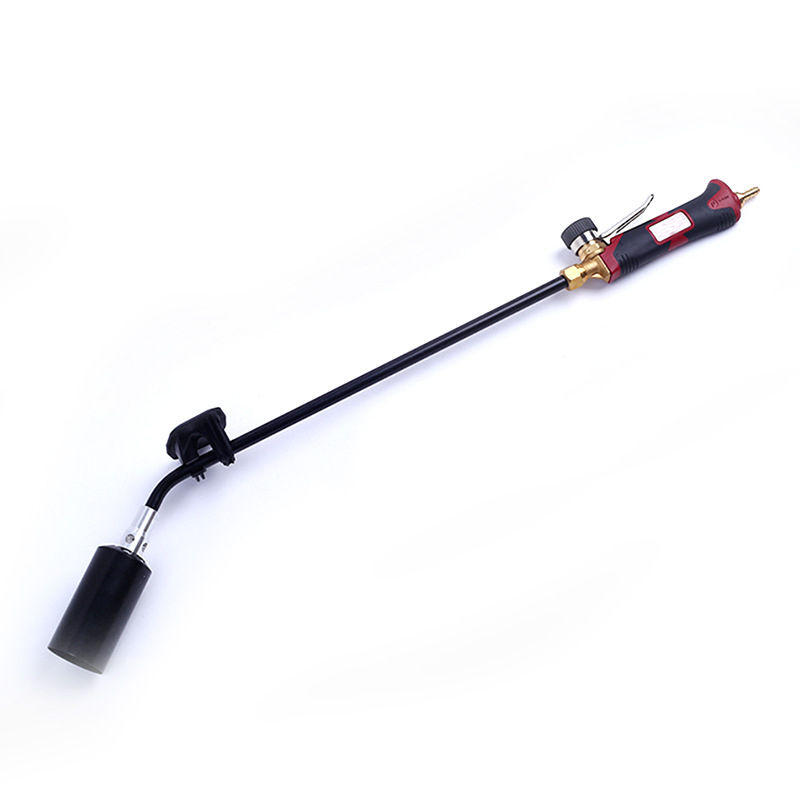Views: 0 Author: Site Editor Publish Time: 2025-09-21 Origin: Site








Lighting a welding torch might seem simple, but it’s crucial for safety and effectiveness. Whether you’re using propane or acetylene, understanding the process is essential. In this article, you’ll learn how to properly light a welding torch and the safety measures to take.
A welding torch is a tool used to generate a flame for welding and cutting metals. Its primary purpose is to melt the base material, allowing for the joining of two pieces or the shaping of metal.
There are several types of welding torches, each designed for specific tasks:
● Propane Torches: Often used for brazing and soldering. They are portable and easy to handle.
● Acetylene Torches: Known for producing a hotter flame, making them ideal for welding thicker materials.
● MAPP Gas Torches: A mixture of gases that burns hotter than propane, suitable for various applications.
Type of Torch | Fuel Source | Common Uses |
Propane | Propane | Soldering, brazing |
Acetylene | Acetylene | Welding, cutting thick metal |
MAPP Gas | MAPP gas | Heating, soldering |
Welding torches are versatile tools used across many industries. Here are some common applications:
1. Metalworking: Essential for fabricating and repairing metal structures.
2. Plumbing: Used for soldering pipes and fittings, ensuring leak-proof connections.
3. Gardening: Helpful in tasks like removing weeds or shaping metal garden structures.
In construction, welding torches are vital for building frameworks. In automotive repair, they help in fixing and modifying parts. Even in art, artists use them to create intricate metal sculptures.
The versatility of welding torches makes them indispensable in both professional and DIY projects. Understanding how to use them effectively can enhance your skills and safety in any task.

Before lighting your welding torch, gather the necessary tools and equipment. Here’s a checklist to help you prepare:
● Welding Torch: The main tool for generating heat.
● Fuel Source: Choose between propane or acetylene.
● Safety Gear: Includes goggles, gloves, and flame-resistant clothing.
Fuel Type | Characteristics | Common Uses |
Propane | Burns cleanly, easy to handle | Soldering, brazing |
Acetylene | Produces a hotter flame, ideal for welding | Cutting, welding thick metals |
Ensuring a stable connection to the gas cylinder's fittings is crucial. Loose connections can lead to leaks, which can be dangerous.
Personal protective equipment (PPE) is vital when working with a welding torch. Here are the key items you should wear:
● Safety Goggles: Protect your eyes from bright light and sparks.
● Gloves: Use heat-resistant gloves to prevent burns.
● Flame-Resistant Clothing: Wear long sleeves and pants to shield your skin.
● Always check your equipment for leaks before lighting the torch. A simple soap and water solution can help identify leaks.
● Keep a fire extinguisher nearby in case of emergencies.
● Avoid using the torch near electromagnetic stoves (电磁炉). This can lead to explosions due to gas buildup.
Following these precautions ensures a safer working environment. Preparing properly is key to a successful welding project.
Before you begin, make sure you have everything you need. Here’s a quick checklist:
● Welding Torch: Your primary tool for generating heat.
● Fuel Source: Choose between propane or acetylene based on your project.
● Safety Gear: Don’t forget goggles, gloves, and flame-resistant clothing.
Using the correct type of fuel is essential. Propane is great for lighter tasks like soldering, while acetylene is better for heavier welding jobs.
Inspecting gas valves is crucial for safety. Here’s how to do it:
1. Check Alignment: Ensure the valves are in the correct position. They should be fully closed before you start.
2. Recommended Pressure Settings:
a. Propane: Typically around 5-10 psi.
b. Acetylene: Should be set to about 10-15 psi.
Proper pressure control is vital. Too high can cause flare-ups; too low may lead to inefficient heating.
When igniting your welding torch, the method you choose matters. Here’s a breakdown:
● Spark Lighter:
○ Advantages: It’s safer and reduces the risk of accidental burns.
○ How to Use: Position the lighter near the torch nozzle. Press the ignition button to create a spark that ignites the gas.
● Open Flame:
○ Caution Required: This method can be riskier. Ensure you’re experienced before attempting it.
○ Procedure: Hold a lit match or lighter close to the nozzle while turning on the gas. Be careful to avoid burns.
Safety is paramount when igniting your welding torch. Here’s what you need to remember:
● Keep a Safe Distance: Always maintain a distance of 6 to 12 inches from the nozzle. This helps prevent burns and ensures you have enough space to react if needed.
● Wear Protective Gear: Always use appropriate safety glasses and gloves.
● Check Surroundings: Ensure there are no flammable materials nearby before igniting the torch.
● Stay Alert: Focus on the task and avoid distractions while lighting.
By following these steps, you can safely ignite your welding torch and start your project with confidence.
Once lit, you’ll want to adjust the flame. Here’s what to know:
● Flame Types:Carburizing Flame:
○ Has excess fuel, ideal for certain welding tasks.
○ Neutral Flame: Balanced, perfect for most welding applications.
Adjust the flame according to your task. For example, brazing requires a different flame than welding. Torches with twist-adjust nozzles offer precise control for optimal results.
After you’re done, follow these important steps:
1. Shutdown Procedures: Turn off the torch and gas cylinder valves in the correct order.
2. Cooling the Nozzle: Allow it to cool before putting it away.
3. Disposing of Empty Gas Cylinders: Follow local guidelines to ensure safety.
These measures help maintain safety and prolong the life of your equipment. Proper care is essential for future use.
Overheating can be a serious issue when using a welding torch. Here’s what you need to know:
● Risks of Overheating: Excess heat can damage the torch and lead to safety hazards. It may cause parts to warp or melt, compromising performance.
● Avoiding Overheating: Always monitor the flame and keep it at a moderate setting. Never leave the torch unattended while lit.
Using a welding torch near electric stoves can be particularly dangerous. The intense heat can cause melting and damage to the stove or surrounding materials. Always keep a safe distance.
Using the wrong type of fuel can lead to significant problems. Here’s why it matters:
● Consequences of Wrong Fuel: For instance, using butane in oxygen-rated torches can lead to explosive reactions. This can damage equipment and pose serious risks to safety.
● Fuel Compatibility: Always check the manufacturer’s guidelines to ensure you’re using the correct fuel type for your torch.
Ignition failures can be frustrating, but they’re often easy to troubleshoot. Here are some common causes:
● Wet Lighters: Ensure your lighter is dry and functioning properly. A wet or faulty lighter can prevent ignition.
● Clogged Nozzles: Debris can block the nozzle, making it difficult to light the torch. Regularly clean the nozzle to avoid this issue.
● Check Connections: Ensure all connections are tight and secure.
● Inspect the Lighter: If it’s not working, try a different one.
● Clean the Torch: Regular maintenance can prevent many ignition issues.
By being aware of these common mistakes, you can ensure a smoother and safer experience when lighting your welding torch.

When it comes to using a welding torch, comfort is key. Here’s why ergonomics matter:
● Lightweight Design: Choosing a lightweight welding torch can significantly reduce fatigue during long projects. It’s easier to handle and maneuver.
● Key Features to Look For:
○ Detachable Triggers: These allow for easy adjustments and can enhance comfort.
○ Compact Handles: A well-designed handle fits comfortably in your hand, providing better control.
Consider ergonomic designs that minimize wrist strain. Look for torches that offer:
● Padded Grips: These can help absorb shock and provide a more comfortable hold.
● Adjustable Angles: Some models allow you to adjust the angle of the torch, reducing awkward wrist positions.
Welding torches can be incredibly versatile. Here’s how:
● Exchangeable Necks: Many torches come with neck options that let you switch between different lengths and angles. This is useful for accessing tight spaces or achieving specific welds.
● Bend Options: Necks can often bend from 35° to 90°, allowing for greater flexibility in various applications. This adaptability can make your work much easier.
Safety should always be a priority when using a welding torch. Here are some features to keep in mind:
● Flame Arrestors: These devices prevent flames from traveling back into the torch, enhancing safety.
● Anti-Roll Designs: A torch that won’t roll off surfaces reduces the risk of accidents.
Make sure your welding torch meets OSHA safety standards. This compliance not only ensures your safety but also promotes best practices in the workplace. Always check for certification labels when purchasing your equipment.
By focusing on ergonomics, versatility, and safety, you can significantly enhance your welding experience.
A: Consider the type of welding you’ll be doing, the required heat output, and the fuel type. Lightweight torches are better for extended use, while exchangeable necks provide versatility for different applications.
A: Yes, but ensure proper ventilation to avoid harmful fumes. Follow safety protocols and check for any flammable materials nearby.
A: Check for wet lighters, clogged nozzles, and secure connections. Clean the nozzle and try using a different lighter if necessary.
Lighting a welding torch requires proper technique and safety. Understanding these aspects is crucial for effective welding.
Always prioritize safe torch operation and regular maintenance. This ensures both your safety and the longevity of your equipment.
Feel free to share your experiences or any questions in the comments below!